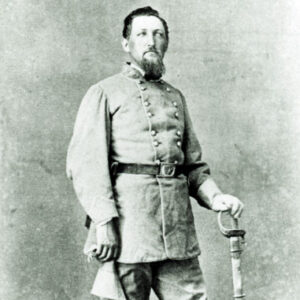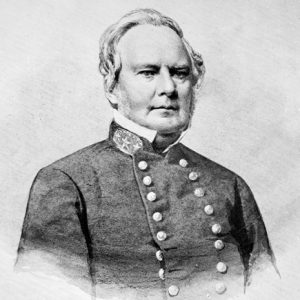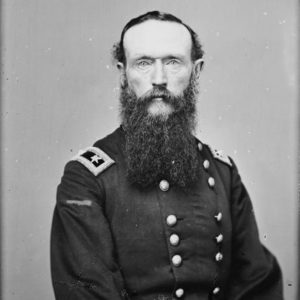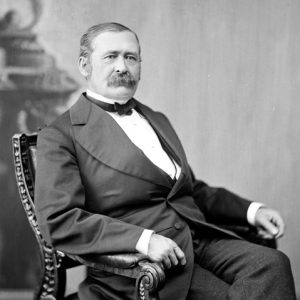calsfoundation@cals.org
Action at Moscow
|
Location: |
|
|
Campaign: |
|
|
Date: |
April 13, 1864 |
|
Principal Commanders: |
Brigadier General John M. Thayer (US); Major General Sterling Price (CS) |
|
Forces Engaged: |
Frontier Division (US); Dockery’s Brigade of Fagan’s Cavalry Division and Second Indian Brigade of Maxey’s Cavalry Division (CS) |
|
Estimated Casualties: |
7 killed, 24 wounded (US); unreported (CS) |
|
Result: |
Union victory |
The Action at Moscow on April 13, 1864, signaled that Major General Frederick Steele’s Union forces would not be allowed to occupy Camden (Ouachita County) without a fight. Although Confederate Washington (Hempstead County) would be spared from Union occupation, the Confederates were not content to merely defend this town—they went on the offensive.
Steele withdrew from Prairie D’Ane (Nevada County) and began marching on Camden on April 12, 1864. His rear guard was the Frontier Division, consisting of about 5,000 men commanded by Brigadier General John M. Thayer. This division was camped near the village of Moscow, on the edge of Prairie D’Ane, on April 13, 1864. Steele’s army made slow progress on its march to Camden, so Thayer’s division was still in camp at noon as the army’s rear-most wagons began to move off.
When it became apparent Steele no longer threatened Washington, Confederate Major General Sterling Price went on the offensive. He dispatched most of the cavalry on another road paralleling Steele’s route in an effort to get ahead of the Union forces and contest their advance on Camden. Price then advanced to attack Steele’s rear guard with the remaining Confederate cavalry; leading Price’s advance were 400 Confederate troops commanded by Brigadier General Thomas P. Dockery.
Deploying his men to the left and right of the road used by the withdrawing Union troops, Dockery advanced on the Union cavalry regiment serving as Thayer’s rear guard at about one o’clock in the afternoon. A correspondent to the Confederate Washington Telegraph said Dockery “instantly moved up and began a hot and impetuous attack.” Thayer realized the seriousness of the attack and called up the Frontier Division’s infantry and artillery to assist the Union cavalrymen. Some of the Union infantrymen had begun preparing to march to Camden, but they quickly joined the artillery in halting Dockery’s attack. Federal cavalryman Wiley Britton recalled, “When this charging force came up within range, the Federal infantry poured several volleys of musketry into their ranks, with fatal precision, and the twelve guns in the batteries of Thayer’s division also swept their ranks and the field in front with a storm of [fire], causing them to retire hastily with a heavy loss of killed and wounded.”
Thayer organized a counterattack. He deployed his cavalry on either side of the Union infantry and artillery, forming a line that overlapped Dockery’s force on both flanks, and ordered an advance. Outnumbered, outgunned, and outflanked, the Confederates commenced a fighting withdrawal. Price then committed the Second Indian Brigade to Dockery’s support; Thayer’s artillery decisively halted their attack. One Union officer explained: “It is well known that the savages are much afraid of ‘big guns,’ and a few shots from our artillery soon sent them to the right about.”
Thayer continued his counterattack, pushing the Confederates three or four miles back across Prairie D’Ane. At 5:00 p.m., the action tapered off. The Frontier Division turned about and marched all night to rejoin the rest of Steele’s army. Reported Union casualties were seven killed and twenty-four wounded; Confederate losses apparently were not reported.
The Action at Moscow was overshadowed by the more momentous actions of Steele’s Camden Expedition, such as the battles of Poison Spring and Jenkins’ Ferry. Still, the action was an indication of what the Union troops could expect in the coming days: Price’s Confederates would continue to contest the Union army’s presence.
For additional information:
Britton, Wiley. The Civil War on the Border. Vol. 2. Ottawa, KS: Kansas Heritage Press, 1994.
McAfee, J. B., ed. Official Military History of Kansas Regiments during the War for the Suppression of the Great Rebellion. Ottawa, KS: Kansas Heritage Press, 1994.
McCormick, Andrew W. “Battles and Campaigns in Arkansas.” In Sketches of War History, 1861–1865, edited by Theodore F. Allen, Edward S. McKee, and J. Gordon Taylor. Wilmington, NC: Broadfoot Publishing Co., 1992.
Frank Arey
Morrilton, Arkansas
 Thomas Dockery
Thomas Dockery  Sterling Price
Sterling Price  Frederick Steele
Frederick Steele  John Thayer
John Thayer 




Comments
No comments on this entry yet.